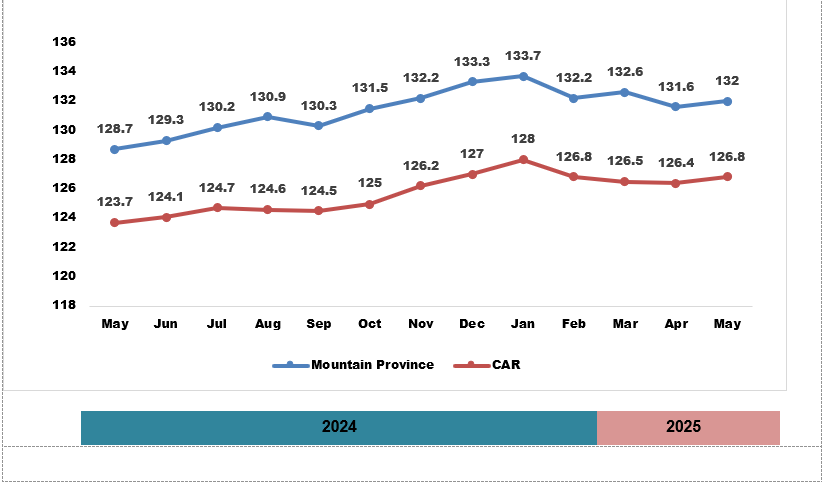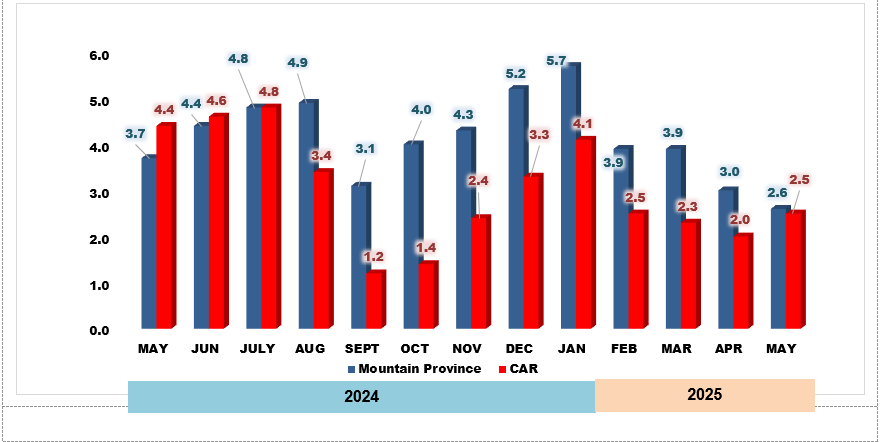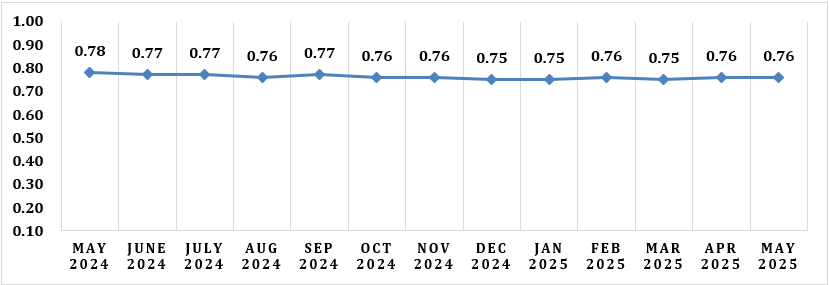Figure 1: Consumer Price Index, All Items: Mountain Province and Cordillera Administrative Region, May 2024 - May 2025
(2018 = 100)

Consumer Price Index in Mountain Province increased to 132.0 percent
The Consumer Price Index for all items in Mountain Province was recorded at 132.0 index points this May 2025. It increased by 0.4 index point from the previous month's record at 131.6 index points.
On a year-on-year basis, the CPI increased by 3.3 percentage points during the month from 128.7 percent in May 2024. The CPI in Mountain Province consistently remains above the Cordillera Administrative Region’s record settling at 126.8 percentage points.
The CPI of 132.0 percent in May 2025 means that using the year 2018 as the base year, there was an increase of 32.0 index points on the average retail prices of a fixed basket of goods and services commonly purchased by households in the province (Figure 1).
Figure 2: Inflation Rates in Mountain Province and Cordillera Administrative Region,
All Items, May 2024 – May 2025
(2018 = 100)

Inflation Rate in Mountain Province decreased to 2.6 percent
The inflation rate in Mountain Province decreased to 2.6 percent in May 2025, recording a decrease of 0.4 percentage points from 3.0 percent in April 2025. In May 2024, the inflation rate was higher at 3.7 percent. The inflation rate of the province is higher compared to the overall inflation rate of the Region at 2.5 percent.
Food and Non-alcoholic Beverages is the main contributory to the downward trend of the May 2025 Inflation Rate
The main contributory to the downward trend of the slower inflation rate based on weight of commodities was primarily due to the deflation of Food and Non-alcoholic Beverages which decreased to 1.5 percent from its 2.0 percent inflation rate in April 2025. Additionally, a decrease in the inflation rates was noted in the following commodity groups during the month:
a. Alcoholic Beverages and Tobacco; 4.4 percent;
b. Housing, water, electricity, gas and other fuels; 8.2 percent;
c. Transport, -3.5 percent; and
d. Restaurants and Accommodation Services, 3.4 percent.
In contrast the commodities, Furnishings, Household Equipment and Routine Maintenance; Health; and Personal Care and Miscellaneous Goods and Services recorded an increase in their inflation rates at 2.1, 5.0 and 4.1 percent in that order.
Meanwhile, inflation rates of the commodities Clothing and Footwear; Information and Communication; Recreation , Sport and Culture; Education Services and Financial Services remained at 0.9, -0.1, 0.6, 0.0 and 0.0 percent respectively when compared to their previous months’ data (Table 1).
Table 1: Inflation Rate for All Income Households by Commodity Group,
Mountain Province: April 2025 – May 2025
(2018 = 100)

Purchasing Power of Peso (PPP) remained at 0.76
The PPP in Mountain Province remained at 0.76 in May 2025 from the recorded PPP in April 2025 at 0.76. This means that a peso in 2018 was worth 76 centavos in May 2025. The PPP in May 2024 was at 0.78 (Figure 3).
Figure 3: Purchasing Power of Peso (PPP) by Month,
Mountain Province: May 2024 – May 2025
(2018=100)

TECHNICAL NOTES
2018-based Consumer Price Index for all Income Households
I. Introduction
The Philippine Statistics Authority (PSA), as mandated by Republic Act No. 10625, is primarily responsible for planning, developing, prescribing, dissemination and enforcing policies, rules and regulations, and coordinates government-wide programs governing the production of official statistics, general-purpose statistics, and civil registration. The Consumer Price Index (CPI) is one of the designated statistics approved under Executive Order No. 352 – Designation of Statistical Activities that will Generate Critical Data for the Decision-Making of the Government and the Private Sector.
1.1 Historical Background
The CPI, formerly called cost of living index, was first constructed by the Labor Statistical Division of the Department of Labor and Employment (DOLE). The task was transferred to the Bureau of Census and Statistics (BCS) (now part of PSA). In 1945, BCS compiled the first series covering only in Manila with 1941 as the base year. Succeeding rebasing was done in 1964, 1965, 1970, 1976, 1982, 1992, 1996, 2000, 2006, 2012, and the current base year 2018.
The 2018-based CPI series was approved on 09 November 2021 through the PSA Board Resolution No. 15, Series of 2021 and was released in the February 2022 for the January 2022 reference period.
The rebasing of the CPI is in accordance with the PSA Board Resolution No. 1, Series of 2017 – 146, which approved the synchronized rebasing of price indices to base year 2006 and six years thereafter.
1.2 Objectives
The CPI measures the change in the average retail prices of a fixed basket of goods and services commonly purchased by the households relative to a base year. It shows how much on the average, prices of goods and services have increased or decreased from a particular reference period known as base year.
Specifically, the CPI is used as follows:
a. Measure of general inflation;
b. Determining the purchasing power of peso;
c. Setting wages and non-wage benefits;
d. Evaluating interest payments, housing rents, and other contractual payments; and
e. Estimating real consumption and income.
1.3 Scope and Coverage
The CPI covers goods and services commonly purchased or availed of by the households. Data are compiled at the provincial and highly urbanized city level.
The specific commodity groups with expenditure data in the Family Income and Expenditure Survey (FIES) will be initially included with the final list determined once the market basket is completed. Only those commodity groups with expenditure weights and corresponding market basket will be included in the CPI computation at the provincial/selected city level.
II. Data Collection
2.1 Data Collection Procedure
Collection of data for the computation of CPI is done through the Retail Price Survey of Selected Commodities for the Generation of CPI. Data are collected from the sample outlets (outlets or establishments where prices of commodities/services are collected or quoted). Price collection is done twice a month. The first collection phase is done during the first five days of the month, while the second phase is on the 15th to 17th day of the month.
Prices for all commodities and cost of services are taken from the same establishments already selected as regular price outlets. Six price quotations are collected for every commodity or service listed in the forms. Two of these six price quotations are taken from the provincial capital, and the other four quotations are from the sample municipalities (Bontoc, Sagada, Bauko, Tadian and Paracelis).
For the second collection phase, only two price quotations are collected for every commodity or service listed in the forms. These are taken from the provincial capital (Bontoc).
2.2 Instruments
Survey forms used are in printable spreadsheet format, which are being used to record the prices collected from the sample outlets.
2.3 Variables/Data Items
The major data item collected is the price of the sample commodities at the time of visit/survey period. In case there is a need to collect prices from stores other than the sample stores due to various reasons, the name and address of the new store will be for inclusion in the database.
III. Methodology
3.1 Unit of Enumeration
The unit of enumeration are the stores or outlets, where the prices of products and services are collected. These stores are selected on predetermined criteria.
3.2 Sample Selection Procedure
Sample stores are selected using the following criteria: (a) Popularity of an establishment along the line of goods to be priced, (b) Consistency and completeness of stock, (c) Permanency of outlet, and (d) Geographical location.
3.3 Estimation Procedure
Statistical weights are applied to the division level down to the Item level of the Philippine Classification of Individual Consumption According to Purpose (PCOICOP). The weights are derived from the expenditure data of the FIES. The weight for each item of expenditure is proportion of that expenditure item to the total national expenditure. The total (all items) national expenditure weights is equal to 100.
Computation of the CPI involves a number of steps as follows:
1. Compute the monthly average price for each commodity
Monthly Average
Price of Commodity =(Price for Outlet 1+Price for Outlet 2+⋯+Price for Outlet k)/k
where:
k = number of outlets for each commodity
2. Compute the price relative (PR) for each commodity
At the Base Year
PR=(Current Month^' s Average Price)/(Annual Average Price in 2018)
After the Base Year
PR=(Current Month^' s Average Price)/(Previous Month's Average Price )
3. Compute the index for 6 – digit of Item Index (Ii(6),t)
At the Base Year
Ii(6),t = Geometric Mean (Pri) x 100After the Base Year
Ii(6),t = Geometric Mean (Pri) x Ii(6),t
4. Compute the index for 5-digit or Sub-class Index (Ij(5),t)
I_(j(5),t)=(∑_i^n▒〖=1 w_(i(6) ) 〗 i_((6),t))/(∑_(i=1)^n▒w_(i(6),t ) )
where:
n = number of items under Sub-class j
wi_6 = weight of item i
5. Compute the higher-level indices
The same formula with Sub-class level index computation is applied to compute for higher level indices.
IV. Concepts and Definitions of Terms
Based Period
It is a reference period, usually a year, at which the index number is set to 100. It is the reference point of the index number series.
Commodity Specification
This refers to the detailed description of the commodity such as brand, packaging, size, and unit of measure or other characteristics that will best describe the product/commodity and are important in the determination of prices.
Consumer Price Index
It is an indicator of the change in the average retail prices of fixed basket of goods and services commonly purchased by an average Filipino household. It shows how much on the average, prices of goods and services have increased or decreased from a particular reference period known as the base year.
Index Number
This is a device used to compare relative movement in the magnitude of a variable or group of distinct but related variables between two or more points in time. An index number also shows the relative differences in the magnitude of a variable obtained at the same period in different areas. It is expressed in percentage form and its unit of measure is percentage point. The base of comparison is taken as 100, facilitating measure of change or difference relative to the base.
Inflation Rate
Refers to the annual rate of change or the year-on-year change of the CPI expressed in percent. Inflation is interpreted in terms of the declining purchasing power of money.
Market Basket
For CPI purposes, market basket is a term used to refer to a sample of goods and services that are commonly purchased and bought by an average Filipino Household.
Philippine Classification of Individual Consumption According to Purpose (PCOICOP)
A detailed classification of individual consumption expenditures on goods and services incurred by the three (household, general government, non-profit institutions serving households) of the five institutional sectors (non-financial corporations, financial corporations) of the 1993 and 2008 Systems of National Accounts (SNA). The PCOICOP was patterned after United Nations COICOP.
Price
The amount or value paid in exchange for a commodity, or a service rendered.
Purchasing Power of Peso (PPP)
Shows how much the peso in the base period is worth in the current period. It is a computed as the reciprocal of the CPI for the period under review multiplied by 100.
Retail/Consumer Price
Refers to the price at which a commodity is sold in small quantities for consumption.
Sample Outlets
These are stores or establishments where prices of sample commodities are quoted.
Unit of Measure
Refers to which commodity is customarily traded in the market. The unity of measure is used as the basis for consistency and to prevent misunderstanding between the price collector and the respondent.
Weight
A value attached to a commodity or a group of commodities to indicate the relative importance of that commodity or group of commodities in the market basket.
V. Dissemination of Results and Revision
The headline CPI, together with derived indicators such as headline inflation rate, core inflation, deseasonalized inflation rate and purchasing power of the peso, is released five days after the reference month through a press release posted on the PSA website. A Press Conference is also held at 9:00AM on the release day.
Revision of previously released data are reflected in the next press release. Revisions are made to include the price data that are submitted beyond the reference period.
VI. Citation
Philippine Statistics Authority. (2025). Technical Notes on the 2018-based Consumer Price Index for All Income Households. https://psa.gov.ph/price-indices/cpi-ir
VII. Contact Information
For additional inquiries regarding CPI for all Income Households, you may send your queries through the following:
JERRY G. SANTOS
Chief Statistical Specialist
RSSOCAR – Mountain Province
Email Address: j.santos@psa.gov.ph
For data requests, you may contact:
Email Address: mtprovince@psa.gov.ph
JERRY G. SANTOS
Chief Statistical Specialist
/MVB

